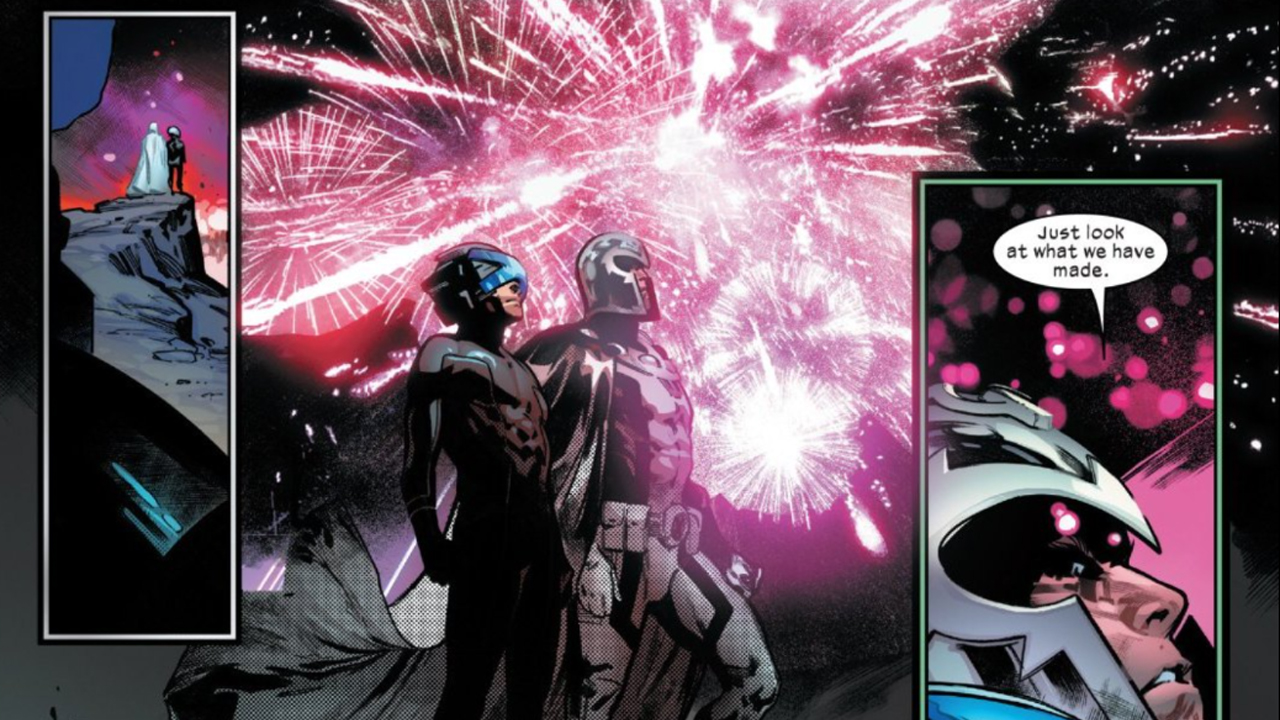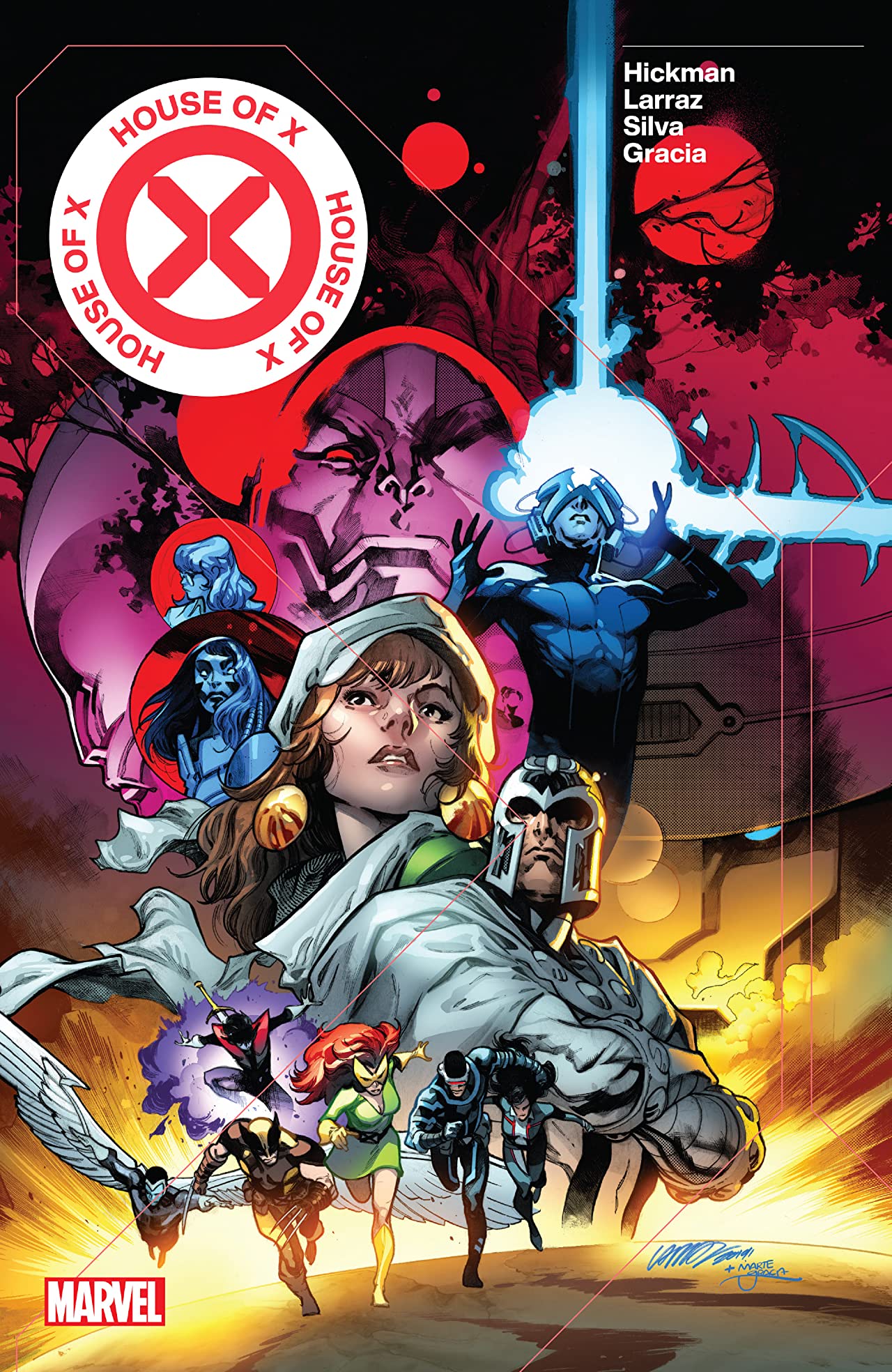Best Shots review: House of X and Powers of X "confident, sleek, and exciting"
"Humans of the planet Earth. While you slept, the world changed." - Professor X

When Marvel announced that Jonathan Hickman would be returning to handle the X-Men, it was an intriguing proposition in and of itself, though amplified by the marketing presenting it as the next big evolution for mutants. One graphic suggested it was to be as monumental as Giant-Size X-Men #1 in the '70s revitalizing the series after its initial cancellation or Grant Morrison and Frank Quietly providing a distinctive take for the new millennium in New X-Men. After reading superhero comic books for long enough, it's easy to become cynical regarding promises that things will never be the same again. Either the dramatic events are never as big as suggested or the effects are a factor the next creative team can easily jettison in favor of the direction they'd like to take a series.
Written by Jonathan Hickman
Art by Pepe Larraz, R.B. Silva, Adriano Di Benedetto, Marte Gracia, and David Curiel
Designed by Tom Muller
Lettered by Clayton Cowles
Published by Marvel Comics
'Rama Rating: 10 out of 10
"Humans of the planet Earth. While you slept, the world changed."
Now collected as both an oversized hardcover and standard trade paperback, in 2019's House of X / Powers of X Hickman calls his shot with the above quote from Professor X, which opens House of X #1. Supplemented by Tom Muller's minimalist design work, the presentation for this story feels like a breath of fresh air right out of the gate. This look isn't just reserved for the credits pages or backmatter but utilized for charts, infographics, and prose built into the structural approach of the series, a necessary component of the overall pacing. Used to explain the purposes of various Krakoan flowers and similar types of information, it grants these details the space to be properly explained and they read much better in this format than if they were part of a character's spoken exposition.
But what is the story they're contributing to tell?

It is at the base level what all X-Men stories are – a tale of survival. Though instead of accepting themselves to be always hated and always feared, these twelve issues show the first steps of mutantdom asserting their dominance as the more advanced species. Not just turning from passive into active, but proactive. House of X #1 predominantly introduces us to what Krakoa has become, while Powers of X #1 jumps ahead years into the future to show the last stand of the remaining mutants against an encroaching technological force, led by Nimrod.
This juxtaposition initially suggests the former is about the start and the latter is about the end, though Hickman's scripting has more than a few tricks up its sleeve with regards to the full chronology of events, as he returns to scenes such as Xavier and Moira MacTaggert's first meeting on a park bench. The approach is never confusing, there's always an obvious purpose to scenes when initially shown, just they're continually being given greater meaning through the wider context of seeing the bigger picture.

This is abundantly true when talking about Moira, who is the most integral part of why Krakoa is what it is. She gets a spotlight issue in House of X #2 to expand on her life's choices. When the series was originally released, this issue's importance was demarcated by red colouring on the publishing schedule. It is home to one of the most inventive gambits of superhero comic books and even if this were the only big swing found in the two series, it would still be enough for the whole experience to warrant the gamechanger moniker. It is not something to spoil in prose such as this when it can be witnessed within the pages of the book, though it can be said fits with the idea of seeing the bigger picture. It treats existing history as something that can be expanded upon rather than altered and turns the bugs inherent in the idea of the status quo and turns them into a textual feature.
Get the best comic news, insights, opinions, analysis and more!
In presenting a bold new world for the X-Men, the two series needed a pair of artists whose work would blow readers away, which brings us to Pepe Larraz and R.B. Silva. The two of them have previously worked on books in the X-line like Extermination and X-Men Blue, but they step up their game here and are matched by the hand of colourist Marte Gracia. (Adriano Di Benedetto also inks Silva for the first two Powers of X issues and David Curiel provides assists with the coloring on each series' final issues in order to get them across the finish line).
Larraz draws House of X, and so is responsible for the first look at this new Krakoa. The verdant setting of the island has been blended with the architecture required to house the many mutants who have made the journey, and yet it never stops feeling like a place of nature. When Jean Grey brings a group of young mutants through a Krakoan gateway for their first time, Gracia uses pinks, purples and blues in addition to the greens and yellow typically associated with the lush outdoors. Meanwhile, Larraz adorns the faces of these youngsters with the widest grins and these choices in tandem are enough in just a couple of pages to really sell the promises of island life.
The far-flung futurized setting first found in Powers of X #1 involves characters never seen before, and only briefly glimpsed, yet Silva still captures the appropriate energy of their fight for survival with the morose tone that the scripting requires. Though his faces are less dynamic – something seen when Larraz eventually draws his version of the Moira and Xavier meeting – his ability to set a scene, even in unfamiliar settings, goes a long way and the physical acting he can provide is strong. The weariness of the dwindling mutants is apparent in their body language and makes for a contrast against the child-like qualities of Nimrod, who waves his fists around in success when his method of handling prisoners is decided to be the best option.

Nature and technology is one of the key dichotomies across these 12 issues, with Powers of X gradually revealing what the endgame of existence appears to be. This is a technique that Hickman has used previously, notably in having a duology of books being published concurrently – Fantastic Four and Future Foundation, then Avengers and New Avengers – as well as positing Steve Rogers as life and Tony Stark as death in the latter pair. Where these X-Men series differ is that there isn't a single thesis statement presented. Such ideas – the aforementioned Xavier quote, "One people. One tribe. One family." and Cyclops asking "Did you honestly think that we were going to sit around forever and just take it?" during an encounter with the Fantastic Four – all work as pieces of a grander thesis.
Krakoa is just as big an idea as it is a place, and so of course an expansive landmass and the ideas behind it cannot be properly captured in a single sentence.
Though the creative team does a lot of work across the two series in establishing this sandbox, they're also aware that they won't be the only ones playing in it. An early infographic shows Krakoa from a satellite view with key areas labeled, while still having plenty of room for others to be defined by other writers if they so choose. Seeds for series are planted throughout in a brief fashion; the initial set-up for the X of Swords crossover features in the background of one panel. While some of these have already been capitalized upon by Hickman himself or other writers like Gerry Duggan and Leah Williams in the line of books that has followed, there is still plenty of territory waiting to be mined. While a set of series like Avengers and New Avengers were designed with precision to deliver a single, particular story, what House of X and Powers of X do is use that same precision to establish a strong base for years of potential stories to come.
While this current moment, just over a year since Powers of X #6 – the last issue in the collection – was published, is still early days for however long the Krakoa era ends up lasting, these twelve issues are thrilling in and of themselves.

They are thoughtful about both continuity and character, primarily because the oversized issues and presentation allow the space for them to be properly considered. They deal with questions of existence as people and as a nation. And when the time comes they deal out some bombastic action, the weight of which comes from Hickman and company granting them meaningful stakes in whether the X-Men win or lose. It's a confident, sleek, and exciting book that justifies its concept, plants seeds, and curates fertile ground that ensures others will be able to be just as bold with the stories they look to tell in this space.
The Professor X quote is particularly appropriate because it does feel like a book that will define all going forward, and if a writer somewhere down the line thinks the X-Men need to go back to living in a mansion in Westchester will need an even bolder pitch to justify such thinking.
House of X/Powers of X is one of the latest additions to our list of the best X-Men stories of all time.
Matt Sibley is a comics critic with Best Shots at Newsarama, who has contributed to the site for many years. Since 2016 in fact.


